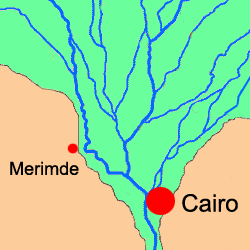 The Merimde settlement was found in 1928 and excavated for seven seasons. Itís located 50 km north-west of Cairo. The area is c. 200.000 m≤ (c. 45 acres) and it may have held up to 10.000 inha- bitants. It was occupied between 5 000 - 4250 BC (early C14 dating) and possibly 500 years earlier when comparing it to cultures in the Faijum to the south.
The Merimde settlement was found in 1928 and excavated for seven seasons. Itís located 50 km north-west of Cairo. The area is c. 200.000 m≤ (c. 45 acres) and it may have held up to 10.000 inha- bitants. It was occupied between 5 000 - 4250 BC (early C14 dating) and possibly 500 years earlier when comparing it to cultures in the Faijum to the south. Large pits might be remains of gran- aries for common use and if so, points to a central organization. People lived in small huts made of wattle and reed with a round or elliptical ground plan. No cemeteries were used but burials were made within the residential area in simple oval shallow pits. Grave goods were rare but could be shells, beads, reed mats and small amulets. Almost all graves found are from women and children, suggesting the adult men were buried where they worked - hunting, fishing or in the fields.
Tools were made of stone/bone/wood and pottery was crude with very simple deco-ration in a fish bone pattern. Food was produced through growing wheat, barley, vetch (a pea) and sorghum (a local grass). Sheep, goat, cattle and pig breeding was frequent as was holding ducks. These animals were of Middle East origin. Bones from over 20 big wild animals were found with gazelles and Hippos atop. Wild birds were also on the menu (40 spices) and the fish from the Nile provided them with an additional 25 dishes plus meat from turtles and crocodiles.
The pear-shaped stone mace head, known from early dynastic royal sites, occur here for the first time, and whether it was used for slaughtering animals or killing enemies is anybodyís guess.
The settlement was by archeologist divided into five layers and faded out when the first metal (copper) came into use and other local cultures further upstream (south) expanded. During the same period the oldest culture by the Faiyum (also to the south) also came to an end.
Merimde had similarities to other centers in the east Mediterranean coastal area, but very little to the south, in what was to be Upper Egypt. At the very end though, some relationship can be observed with the fading Faiyum A culture 200 km upstream. Notably small rather crude sculptured clay figurines of people is here seen for the first time in the Nile Valley.
